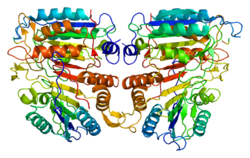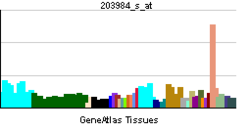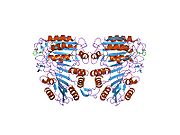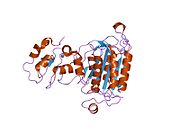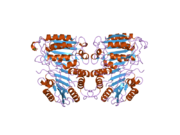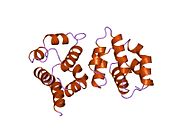- Caspase-9
-
Caspase-9 is an initiator caspase,[1] encoded by the CASP9 gene. CASP9 orthologs [2] have been identified in all mammals for which complete genome data are available. Unique orthologs are also present in lizards, lissamphibians, and teleosts.
The aspartic acid specific protease caspase-9 has been linked to the mitochondrial death pathway. It is activated during programmed cell death (apoptosis). Induction of stress signaling pathways JNK/SAPK causes release of cytochrome c from mitochondria and activation of apaf-1 (apoptosome), which in turn cleaves the pro-enzyme of caspase-9 into the active form.
Once initiated caspase-9 goes on to cleave procaspase-3 & procaspase-7, which cleave several cellular targets, including poly ADP ribose polymerase.
Contents
Interactions
Caspase-9 has been shown to interact with NLRP1,[3][4] XIAP,[5][6][7][8] Baculoviral IAP repeat-containing protein 3,[7] BIRC2,[7] APAF1[3][9][10][11][12] and Caspase 8.[13][14]
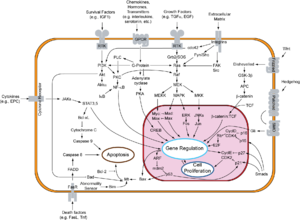 Overview of signal transduction pathways involved in apoptosis.
Overview of signal transduction pathways involved in apoptosis.
See also
- The Proteolysis Map
References
- ^ Caspase 9
- ^ "OrthoMaM phylogenetic marker: CASP9 coding sequence". http://www.orthomam.univ-montp2.fr/orthomam/data/cds/detailMarkers/ENSG00000132906_CASP9.xml.
- ^ a b Chu, Z L; Pio F, Xie Z, Welsh K, Krajewska M, Krajewski S, Godzik A, Reed J C (Mar. 2001). "A novel enhancer of the Apaf1 apoptosome involved in cytochrome c-dependent caspase activation and apoptosis". J. Biol. Chem. (United States) 276 (12): 9239–45. doi:10.1074/jbc.M006309200. ISSN 0021-9258. PMID 11113115.
- ^ Hlaing, T; Guo R F, Dilley K A, Loussia J M, Morrish T A, Shi M M, Vincenz C, Ward P A (Mar. 2001). "Molecular cloning and characterization of DEFCAP-L and -S, two isoforms of a novel member of the mammalian Ced-4 family of apoptosis proteins". J. Biol. Chem. (United States) 276 (12): 9230–8. doi:10.1074/jbc.M009853200. ISSN 0021-9258. PMID 11076957.
- ^ Rual, Jean-François; Venkatesan Kavitha, Hao Tong, Hirozane-Kishikawa Tomoko, Dricot Amélie, Li Ning, Berriz Gabriel F, Gibbons Francis D, Dreze Matija, Ayivi-Guedehoussou Nono, Klitgord Niels, Simon Christophe, Boxem Mike, Milstein Stuart, Rosenberg Jennifer, Goldberg Debra S, Zhang Lan V, Wong Sharyl L, Franklin Giovanni, Li Siming, Albala Joanna S, Lim Janghoo, Fraughton Carlene, Llamosas Estelle, Cevik Sebiha, Bex Camille, Lamesch Philippe, Sikorski Robert S, Vandenhaute Jean, Zoghbi Huda Y, Smolyar Alex, Bosak Stephanie, Sequerra Reynaldo, Doucette-Stamm Lynn, Cusick Michael E, Hill David E, Roth Frederick P, Vidal Marc (Oct. 2005). "Towards a proteome-scale map of the human protein-protein interaction network". Nature (England) 437 (7062): 1173–8. doi:10.1038/nature04209. PMID 16189514.
- ^ Davoodi, Jamshid; Lin Lily, Kelly John, Liston Peter, MacKenzie Alexander E (Sep. 2004). "Neuronal apoptosis-inhibitory protein does not interact with Smac and requires ATP to bind caspase-9". J. Biol. Chem. (United States) 279 (39): 40622–8. doi:10.1074/jbc.M405963200. ISSN 0021-9258. PMID 15280366.
- ^ a b c Deveraux, Q L; Roy N, Stennicke H R, Van Arsdale T, Zhou Q, Srinivasula S M, Alnemri E S, Salvesen G S, Reed J C (Apr. 1998). "IAPs block apoptotic events induced by caspase-8 and cytochrome c by direct inhibition of distinct caspases". EMBO J. (ENGLAND) 17 (8): 2215–23. doi:10.1093/emboj/17.8.2215. ISSN 0261-4189. PMC 1170566. PMID 9545235. http://www.pubmedcentral.nih.gov/articlerender.fcgi?tool=pmcentrez&artid=1170566.
- ^ Richter, B W; Mir S S, Eiben L J, Lewis J, Reffey S B, Frattini A, Tian L, Frank S, Youle R J, Nelson D L, Notarangelo L D, Vezzoni P, Fearnhead H O, Duckett C S (Jul. 2001). "Molecular Cloning of ILP-2, a Novel Member of the Inhibitor of Apoptosis Protein Family". Mol. Cell. Biol. (United States) 21 (13): 4292–301. doi:10.1128/MCB.21.13.4292-4301.2001. ISSN 0270-7306. PMC 87089. PMID 11390657. http://www.pubmedcentral.nih.gov/articlerender.fcgi?tool=pmcentrez&artid=87089.
- ^ Cho, Dong-Hyung; Hong Yeon-Mi, Lee Ho-June, Woo Ha-Na, Pyo Jong-Ok, Mak Tak W, Jung Yong-Keun (Sep. 2004). "Induced inhibition of ischemic/hypoxic injury by APIP, a novel Apaf-1-interacting protein". J. Biol. Chem. (United States) 279 (38): 39942–50. doi:10.1074/jbc.M405747200. ISSN 0021-9258. PMID 15262985.
- ^ Li, P; Nijhawan D, Budihardjo I, Srinivasula S M, Ahmad M, Alnemri E S, Wang X (Nov. 1997). "Cytochrome c and dATP-dependent formation of Apaf-1/caspase-9 complex initiates an apoptotic protease cascade". Cell (UNITED STATES) 91 (4): 479–89. doi:10.1016/S0092-8674(00)80434-1. ISSN 0092-8674. PMID 9390557.
- ^ Hu, Y; Benedict M A, Wu D, Inohara N, Núñez G (Apr. 1998). "Bcl-XL interacts with Apaf-1 and inhibits Apaf-1-dependent caspase-9 activation". Proc. Natl. Acad. Sci. U.S.A. (UNITED STATES) 95 (8): 4386–91. doi:10.1073/pnas.95.8.4386. ISSN 0027-8424. PMC 22498. PMID 9539746. http://www.pubmedcentral.nih.gov/articlerender.fcgi?tool=pmcentrez&artid=22498.
- ^ Pan, G; O'Rourke K, Dixit V M (Mar. 1998). "Caspase-9, Bcl-XL, and Apaf-1 form a ternary complex". J. Biol. Chem. (UNITED STATES) 273 (10): 5841–5. doi:10.1074/jbc.273.10.5841. ISSN 0021-9258. PMID 9488720.
- ^ Guo, Yin; Srinivasula Srinivasa M, Druilhe Anne, Fernandes-Alnemri Teresa, Alnemri Emad S (Apr. 2002). "Caspase-2 induces apoptosis by releasing proapoptotic proteins from mitochondria". J. Biol. Chem. (United States) 277 (16): 13430–7. doi:10.1074/jbc.M108029200. ISSN 0021-9258. PMID 11832478.
- ^ Srinivasula, S M; Ahmad M, Fernandes-Alnemri T, Litwack G, Alnemri E S (Dec. 1996). "Molecular ordering of the Fas-apoptotic pathway: The Fas/APO-1 protease Mch5 is a CrmA-inhibitable protease that activates multiple Ced-3/ICE-like cysteine proteases". Proc. Natl. Acad. Sci. U.S.A. (UNITED STATES) 93 (25): 14486–91. doi:10.1073/pnas.93.25.14486. ISSN 0027-8424. PMC 26159. PMID 8962078. http://www.pubmedcentral.nih.gov/articlerender.fcgi?tool=pmcentrez&artid=26159.
External links
Further reading
- Cohen GM (1997). "Caspases: the executioners of apoptosis". Biochem. J. 326 ( Pt 1) (Pt 1): 1–16. PMC 1218630. PMID 9337844. http://www.pubmedcentral.nih.gov/articlerender.fcgi?tool=pmcentrez&artid=1218630.
- Deveraux QL, Reed JC (1999). "IAP family proteins--suppressors of apoptosis". Genes Dev. 13 (3): 239–52. doi:10.1101/gad.13.3.239. PMID 9990849.
- Zhao LJ, Zhu H (2005). "Structure and function of HIV-1 auxiliary regulatory protein Vpr: novel clues to drug design". Curr. Drug Targets Immune Endocr. Metabol. Disord. 4 (4): 265–75. doi:10.2174/1568008043339668. PMID 15578977.
- Le Rouzic E, Benichou S (2006). "The Vpr protein from HIV-1: distinct roles along the viral life cycle". Retrovirology 2: 11. doi:10.1186/1742-4690-2-11. PMC 554975. PMID 15725353. http://www.pubmedcentral.nih.gov/articlerender.fcgi?tool=pmcentrez&artid=554975.
- Moon HS, Yang JS (2006). "Role of HIV Vpr as a regulator of apoptosis and an effector on bystander cells". Mol. Cells 21 (1): 7–20. PMID 16511342.
- Kopp S (1976). "Reproducibility of response to a questionnaire on symptoms of masticatory dysfunction". Community dentistry and oral epidemiology 4 (5): 205–9. doi:10.1111/j.1600-0528.1976.tb00985.x. PMID 1067155.
- Fernandes-Alnemri T, Litwack G, Alnemri ES (1995). "CPP32, a novel human apoptotic protein with homology to Caenorhabditis elegans cell death protein Ced-3 and mammalian interleukin-1 beta-converting enzyme". J. Biol. Chem. 269 (49): 30761–4. PMID 7983002.
- Duan H, Orth K, Chinnaiyan AM, et al. (1996). "ICE-LAP6, a novel member of the ICE/Ced-3 gene family, is activated by the cytotoxic T cell protease granzyme B". J. Biol. Chem. 271 (28): 16720–4. doi:10.1074/jbc.271.28.16720. PMID 8663294.
- Srinivasula SM, Fernandes-Alnemri T, Zangrilli J, et al. (1996). "The Ced-3/interleukin 1beta converting enzyme-like homolog Mch6 and the lamin-cleaving enzyme Mch2alpha are substrates for the apoptotic mediator CPP32". J. Biol. Chem. 271 (43): 27099–106. doi:10.1074/jbc.271.43.27099. PMID 8900201.
- Srinivasula SM, Ahmad M, Fernandes-Alnemri T, et al. (1997). "Molecular ordering of the Fas-apoptotic pathway: The Fas/APO-1 protease Mch5 is a CrmA-inhibitable protease that activates multiple Ced-3/ICE-like cysteine proteases". Proc. Natl. Acad. Sci. U.S.A. 93 (25): 14486–91. doi:10.1073/pnas.93.25.14486. PMC 26159. PMID 8962078. http://www.pubmedcentral.nih.gov/articlerender.fcgi?tool=pmcentrez&artid=26159.
- Kothakota S, Azuma T, Reinhard C, et al. (1997). "Caspase-3-generated fragment of gelsolin: effector of morphological change in apoptosis". Science 278 (5336): 294–8. doi:10.1126/science.278.5336.294. PMID 9323209.
- Li P, Nijhawan D, Budihardjo I, et al. (1997). "Cytochrome c and dATP-dependent formation of Apaf-1/caspase-9 complex initiates an apoptotic protease cascade". Cell 91 (4): 479–89. doi:10.1016/S0092-8674(00)80434-1. PMID 9390557.
- Pan G, O'Rourke K, Dixit VM (1998). "Caspase-9, Bcl-XL, and Apaf-1 form a ternary complex". J. Biol. Chem. 273 (10): 5841–5. doi:10.1074/jbc.273.10.5841. PMID 9488720.
- Hu Y, Benedict MA, Wu D, et al. (1998). "Bcl-XL interacts with Apaf-1 and inhibits Apaf-1-dependent caspase-9 activation". Proc. Natl. Acad. Sci. U.S.A. 95 (8): 4386–91. doi:10.1073/pnas.95.8.4386. PMC 22498. PMID 9539746. http://www.pubmedcentral.nih.gov/articlerender.fcgi?tool=pmcentrez&artid=22498.
- Deveraux QL, Roy N, Stennicke HR, et al. (1998). "IAPs block apoptotic events induced by caspase-8 and cytochrome c by direct inhibition of distinct caspases". EMBO J. 17 (8): 2215–23. doi:10.1093/emboj/17.8.2215. PMC 1170566. PMID 9545235. http://www.pubmedcentral.nih.gov/articlerender.fcgi?tool=pmcentrez&artid=1170566.
- Srinivasula SM, Ahmad M, Fernandes-Alnemri T, Alnemri ES (1998). "Autoactivation of procaspase-9 by Apaf-1-mediated oligomerization". Mol. Cell 1 (7): 949–57. doi:10.1016/S1097-2765(00)80095-7. PMID 9651578.
- Kamada S, Kusano H, Fujita H, et al. (1998). "A cloning method for caspase substrates that uses the yeast two-hybrid system: Cloning of the antiapoptotic gene gelsolin". Proc. Natl. Acad. Sci. U.S.A. 95 (15): 8532–7. doi:10.1073/pnas.95.15.8532. PMC 21110. PMID 9671712. http://www.pubmedcentral.nih.gov/articlerender.fcgi?tool=pmcentrez&artid=21110.
- Cardone MH, Roy N, Stennicke HR, et al. (1998). "Regulation of cell death protease caspase-9 by phosphorylation". Science 282 (5392): 1318–21. doi:10.1126/science.282.5392.1318. PMID 9812896.
- Hu Y, Ding L, Spencer DM, Núñez G (1999). "WD-40 repeat region regulates Apaf-1 self-association and procaspase-9 activation". J. Biol. Chem. 273 (50): 33489–94. doi:10.1074/jbc.273.50.33489. PMID 9837928.
- Lei K, Nimnual A, Zong W, Kennedy N, Flavell R, Thompson C, Bar-Sagi D, Davis R (2002). "The Bax Subfamily of Bcl2-Related Proteins Is Essential for Apoptotic Signal Transduction by c-Jun NH2-Terminal Kinase". Mol Cell Biol 22 (13): 4929–42. doi:10.1128/MCB.22.13.4929-4942.2002. PMC 133923. PMID 12052897. http://www.pubmedcentral.nih.gov/articlerender.fcgi?tool=pmcentrez&artid=133923.
- Earnshaw W, Martins L, Kaufmann S (1999). "Mammalian caspases: structure, activation, substrates, and functions during apoptosis". Annu Rev Biochem 68: 383–424. doi:10.1146/annurev.biochem.68.1.383. PMID 10872455.
PDB gallery Caspase Caspase 1 · Caspase 2 · Caspase 3 · Caspase 4 · Caspase 5 · Caspase 6 · Caspase 7 · Caspase 8 · Caspase 9 · Caspase 10 · Caspase 12 · Caspase 13 · Caspase 14Fruit-derived Calpain Cathepsin Other Apoptosis signaling pathway Fas path IntracellularDeath-inducing signaling complex
DAXX · ASK1
Cytochrome c · Caspase 9 · Caspase 3
pro-apoptotic: BAX · BAK1/Bcl-2 homologous antagonist killer · Bcl-2-associated death promoter
anti-apoptotic: Bcl-2 · Bcl-xLTNF path IntracellularOther IntracellularCategories:- Human proteins
- Enzymes
Wikimedia Foundation. 2010.

